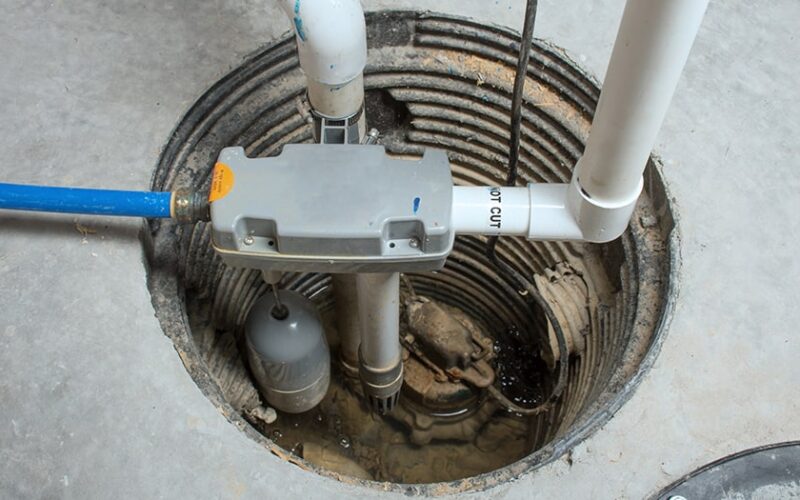A sump pump is an important component of your home that prevents groundwater or rainwater from entering your basement. Water drains from beneath or around your home into a sump pump pit, where it is pumped out of your home and away from the foundation. A sump pump, like any other system or equipment in your home, requires regular maintenance to perform correctly. This post will go over important sump pump maintenance guidelines and their cost that you should be aware of. These maintenance instructions will assist you in keeping your sump pump in good working order.
What Is a Sump Pump?
A sump pump is a small, electrically powered water pump that is installed in a lined hole known as a sump pit. The pump is intended to be immersed in water. When the water level in the sump pit reaches a specified level, the sump pump activates and expels the water. When the water level lowers sufficiently, the pump shuts down. So the sump pump is always on watch; it protects your home 24 hours a day, seven days a week.
What Is the Purpose of a Sump Pump?
#1. Expels Ordinary Groundwater
First and foremost, a sump pump will regularly free your home of groundwater infiltration. This is the most common application for a sump pump. When a sump pump activates, it is no reason for concern because the pump is merely performing its function.
Groundwater entering the home from below or sideways is gathered by permeable rock-filled drains and directed to the sump pit, where the pump returns it to the outside.
#2. Dispenses with Flooding Water
Second, and far less frequent, a sump pump has the ability to remove significant amounts of water in the event of an unforeseen water event. Higher-quality sump pumps can discharge up to 4,000 to 5,000 gallons per hour.
This means that your home’s sump pump might, in principle, discharge water after a catastrophic occurrence such as minor flooding or a broken water supply pipe. In actuality, this is rarely the case. Sump pumps are mostly used to deal with regular groundwater intrusion.
Do Sump Pumps Need Maintenance?
Water drains from beneath or around your home into a sump pump pit, where it is pumped out of your home and away from the foundation. A sump pump, like any other system or equipment in your home, requires regular maintenance to perform correctly.
Sump Pump Maintenance
A faulty sump pump is unlikely to be noticed until it fails to function when it is most required. Basement flooding and water damage could be severe by then. Sump pump maintenance should be performed on a regular basis every three to four months, with a more extensive process performed once a year.
Quarterly Sump Pump Maintenance Tasks
- Unplug the pump and dump any standing water from the basin.
- Remove any debris from the basin and ensure that the sump pump inlet screen is clear and not clogged.
- Plugin the pump and dump five liters of water into the sump to ensure that the float switch properly turns the pump on and off.
Annual maintenance of Sump Pump
Some of these jobs may be handled by knowledgeable homeowners, but if you’re unsure, it’s far preferable to hire a competent professional to do it perfectly the first time.
- Unplug the pump and take it out of the basin for inspection. Check for rust or corrosion. Remove the pump inlet screen and clean it.
- Examine the owner’s manual to check if the pump bearings need to be lubricated. If this is the case, lube with the prescribed oil or grease. Pumps with sealed bearings do not need to be lubricated.
- Remove any debris from the sump basin.
- Reinstall the pump and reconnect it to the power outlet.
- Pour five liters of water into the basin and see the float switch in action. Check that it travels through its whole range of motion without binding and that it switches the pump on and off at the correct times.
- Examine the condition of the pump discharge pipe outside. Check that it is not obscured by dirt or foliage. Also, make sure it drains completely and doesn’t have any remaining water that could freeze and burst the pipe or hinder appropriate flow in the winter.
What Should a Professional Check During a Sump Pump Maintenance?
According to InterNACHI, there are six things a professional should look for during an annual sump pump inspection.
- A pit. A sump pump lies in a pit that collects and accumulates water until it is removed by the pump. According to the InterNACHI, the pit should be at least 24 inches deep and 18 inches broad in order for the sump pump to function effectively.
- A check valve A expert should inspect the discharge pipe to ensure that there is a working check valve. The check valve prevents water from pouring back down into the pit after the pump is turned off.
- A backup power supply. Sump pumps may need to work harder during extreme weather conditions, such as when heavy rains caused power outages. So, a specialist can confirm whether or not a sump pump has a backup power source, such as a battery, and that it is in good operating order.
Read Also: A Guide to Sewer Scope Inspection 2022: Overview and Importance
4. The alarm. While it is not mandatory for all sump pumps to include sirens that sound when the device is triggered, they can help inform a homeowner that there is water buildup in the pit. If a sump pump has one, it should be inspected to verify good operation.
- The front cover. Sump pump pits collect water and should have a detachable cover to keep water from evaporating into the basement. An expert will ensure that it fits properly and, if necessary, will assist in the addition of one.
- The discharge site. A specialist can notify homeowners if the discharge location of their sump pump is incorrect. It is advised that the discharge position be at least 20 feet away from home to assist prevent water from flowing back towards the house — and it should not leak into neighboring properties, into public sewer systems, or into a domestic septic system.
Keep in mind that a sump pump can help keep excess groundwater or rains from entering your home. You can help keep your sump pump running smoothly and your basement or crawl area dry by performing routine maintenance.
Solutions to Common Sump Pump Issues
If your sump pump isn’t working properly or isn’t working at all, most solutions are easy and affordable. The electrical connection, water input and discharge, and the float and switch mechanisms are all addressed in these adjustments.
#1. The Sump Pump Isn’t Turning On
The water level may be too low for activities to begin. Also, alternatively, you could have a blown fuse or a tripped circuit breaker on the service panel. Finally, remove the pump and inspect the inlet valve to ensure it is not clogged with debris.
#2. The sump pump does not turn off.
Check to determine if the pump’s float switch is working properly. If this is not the case, the switch should be replaced. Examine the discharge pipe for any obstructions. A sump pump that is continually running may also be undersized for the purpose. So, the only answer is to upgrade to a higher-level pump with a higher discharge.
#3. Too frequently, the sump pump starts and stops.
A faulty sump pump could be the source of the problem. However, the solution is frequently simpler and less expensive: the discharge pipe may have a blockage that causes backflow. As a result, water that attempts to discharge is prevented from doing so. The water flows backward, filling the sump pit and reactivating the sump pump.
Read Also: TRANSIT LEVEL: 5 Best Transit Levels In 2022
When Should You Replace Your Sump Pump?
Should you replace an old but still functional sump pump? While the subject of replacing working equipment is always disputed, some experts believe that sump pumps, whether working or not, should be replaced every ten years.
If the motor fails, it is frequently a complicated repair that may cost more than replacing the complete sump pump. So, the majority of sump pump manufacturers’ limited warranties range from three to five years.
How Much Does Sump Pump Preventative Maintenance Cost?
Maintenance is an often-overlooked component that influences the cost and frequency of sump pump repairs. Professional maintenance once a year might help to extend the life and reliability of your sump pump. It also allows for the detection and repair of minor flaws before they progress and damage other elements of the machine.
Minor repairs, such as those discovered during maintenance sessions, will assist ensure that your pump lives to its full potential. Annual maintenance cost is between $150 and $250, depending on the kind of your sump pump. The cost of avoiding a pricey, unexpected replacement is certainly worth it.
There are also a number of simple maintenance tasks that homeowners may perform on their own to ensure that their pumps are ready for rainy weather.
Additional Thoughts
A few other elements determine the cost of sump pump maintenance services. Here are a few other items to consider when calculating the cost of the sump pump maintenance:
#1. Insurance
Insurance plans may cover sump pump failure and repairs. It’s not something that’s usually included by default, so you’ll have to ask your insurance carrier to add it to your policy. If your insurance carrier does not cover it, you can get it from the National Flood Insurance Program independently. Pump repairs and replacements will be covered by insurance, requiring you to pay less out of cash.
#2. Filters
Filters can assist avoid sump pump damage and lower the frequency and expense of repairs. Sediment and other debris sucked up by your pump might cause clogs and wear-out components that will need to be replaced. Filters are a low-cost investment, costing between $15 and $25 per unit.
#3. Maintenance
If you reside in an area where winter temperatures drop below freezing, you should perform some extra preventative maintenance to ensure your sump pump survives the cold. Many sump pumps are equipped with a hose that directs water away from the pit. Water sitting inside the hose during an extreme cold might freeze and form a blockage. When more water tries to drain through the hose, it causes a backup and floods your basement. This not only ruins your sump pump, which will necessitate professional repair, but it can also cause chaos in your home. A replacement sump pump hose will cost anywhere from $15 to $60, depending on its length and quality.
#4. Reserve Pumps:
Reserve pumps are popular in flood-prone locations with severe rainfall. The reserve pump is a backup that kicks in when your primary pump becomes overburdened by the volume of water it is attempting to move. While a reserve pump might be a lifeline (literally) in the event of a flood, it also necessitates more maintenance and repair. The installation of a backup sump pump ranges from $1,000 to $4,500.
Unit prices are high, but clever homeowners can save money on labor by conducting a DIY installation.
Sump Pump Maintenance FAQs
How often should you have your sump pump serviced?
The sump pump and pit require maintenance once a year.
How many years does a sump pump last?
Your sump pump, like other appliances and equipment in your home, will not survive forever. With a lifespan of around ten years, you may not notice a problem with your sump pump until it stops working.
Can I pour vinegar in my sump pump?
Vinegar is a very acidic chemical. Its enzymes aid in the breakdown of even the most stubborn filth, dirt, and grease. It’s not only a great cleaning option for floors, tiles, and bathtubs, but it’s also an excellent sump pump cleaner.
How do I clean my sump pump pit?
Rinse the dirt from the pump’s surface with a garden hose and wipe away any trapped debris with a plastic scraper. Then you may hang it to dry. Using a shop vac, remove any standing water in your sump pit. If the check valve can be disassembled, you can do so to drain any residual water.






